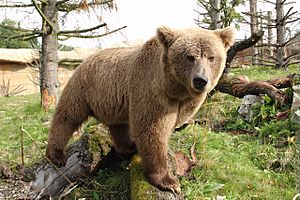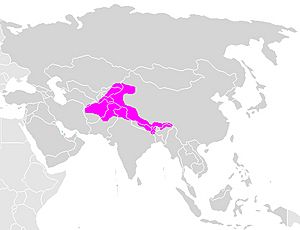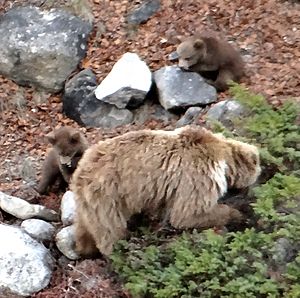Himalayan brown bear facts for kids
Quick facts for kids Himalayan brown bear |
|
|---|---|
 |
|
| Himalayan brown bear | |
| Conservation status | |
| Scientific classification |
|
| Kingdom: | Animalia |
| Phylum: | Chordata |
| Class: | Mammalia |
| Order: | Carnivora |
| Family: | Ursidae |
| Genus: | Ursus |
| Species: | |
| Subspecies: |
U. a. isabellinus
|
| Trinomial name | |
| Ursus arctos isabellinus Horsfield, 1826
|
|
 |
|
| Himalayan brown bear range | |
The Himalayan brown bear (Ursus arctos isabellinus) is a special type of brown bear found in the western Himalayas. It's also known by other names like the Himalayan red bear or isabelline bear. Some people even call it the Dzu-Teh. This bear is the biggest animal in its region. Male bears can grow up to about 2.2 meters (7.2 feet) long. Female bears are a bit smaller. Himalayan brown bears eat both plants and animals. They also hibernate during the cold winter months.
Contents
What Do Himalayan Brown Bears Look Like?
Himalayan brown bears show differences between males and females. This is called sexual dimorphism. Male bears are usually between 1.5 and 2.2 meters (4.9 to 7.2 feet) long. Female bears are a bit shorter, from 1.37 to 1.83 meters (4.5 to 6.0 feet) long. Their fur is often sandy or reddish-brown in color.
Where Do Himalayan Brown Bears Live?
These bears live in the western part of the Himalayas. You can find them in northeastern Pakistan. They also live in the Indian states of Jammu and Kashmir, Himachal Pradesh, and Uttarakhand. Their home extends into the Himalayas of central Nepal. Scientists are still learning if these bears are connected to other brown bear groups. These other groups live in the Karakoram Mountains and on the Tibetan Plateau.
How Do Himalayan Brown Bears Live?
Hibernation Habits
Himalayan brown bears go into hibernation around October. They wake up and come out of their dens in April and May. Hibernation is a deep sleep that helps them survive winter. They usually make a den or find a cave for this long sleep.
What Do Himalayan Brown Bears Eat?
Himalayan brown bears are omnivores. This means they eat both plants and animals. They enjoy grasses, roots, and other plants. They also eat insects and small mammals. Fruits and berries are a favorite treat for them. Sometimes, they will hunt larger animals. This can include sheep and goats. Adult bears usually eat early in the morning before sunrise. They also eat again later in the afternoon.
Why Are Himalayan Brown Bears in Danger?
Himalayan brown bears face several threats. People sometimes hunt them illegally, which is called poaching. Their fur and claws are used for decorations. Their internal organs are sometimes used in traditional medicines. Shepherds also kill them to protect their farm animals.
In Himachal Pradesh, these bears live in special protected areas. These include the Kugti and Tundah wildlife sanctuaries. They also live in the tribal Chamba region. The buransh tree is the state flower of Himachal. It is also a favorite home for the Himalayan brown bear. Sadly, these trees are cut down for money. This destroys the bears' habitat even more.
Himalayan Brown Bears and the Yeti Legend
The name "Dzu-Teh" is a Nepalese term for this bear. It has also been linked to the legend of the Yeti. The Yeti is also known as the Abominable Snowman. Sometimes, people have confused the bear with the Yeti.
In 1954, during an expedition, a "Dzu-Teh" was seen. This story was told in a book about the Abominable Snowman. More recently, in 2017, scientists studied DNA from an animal thought to be a Yeti. The DNA showed it was actually a Himalayan brown bear.
Himalayan Brown Bears in Movies
- The 2016 movie based on Rudyard Kipling's The Jungle Book shows Baloo as a Himalayan brown bear.
See also
 In Spanish: Oso pardo del Himalaya para niños
In Spanish: Oso pardo del Himalaya para niños



